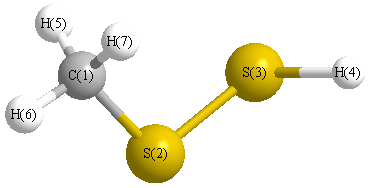Vibrational Frequencies calculated at HF/cc-pCVTZ
| Mode Number |
Symmetry |
Frequency
(cm-1) |
Scaled Frequency
(cm-1) |
IR Intensities
(km mol-1) |
Raman Act
(Å4/u) |
Dep P |
Dep U |
|---|
| 1 |
A |
3277 |
2992 |
10.94 |
56.89 |
0.75 |
0.86 |
| 2 |
A |
3258 |
2975 |
9.83 |
82.42 |
0.75 |
0.86 |
| 3 |
A |
3178 |
2902 |
26.28 |
158.96 |
0.02 |
0.04 |
| 4 |
A |
2824 |
2579 |
3.84 |
149.80 |
0.27 |
0.42 |
| 5 |
A |
1599 |
1460 |
7.53 |
6.40 |
0.74 |
0.85 |
| 6 |
A |
1580 |
1443 |
7.82 |
7.75 |
0.75 |
0.86 |
| 7 |
A |
1477 |
1349 |
6.80 |
0.16 |
0.21 |
0.34 |
| 8 |
A |
1066 |
973 |
6.64 |
2.25 |
0.24 |
0.38 |
| 9 |
A |
1058 |
966 |
1.23 |
1.37 |
0.73 |
0.85 |
| 10 |
A |
977 |
892 |
5.19 |
8.84 |
0.64 |
0.78 |
| 11 |
A |
760 |
694 |
1.22 |
18.06 |
0.31 |
0.47 |
| 12 |
A |
558 |
509 |
0.71 |
20.04 |
0.20 |
0.33 |
| 13 |
A |
338 |
309 |
16.37 |
5.00 |
0.75 |
0.86 |
| 14 |
A |
262 |
239 |
0.12 |
4.36 |
0.58 |
0.74 |
| 15 |
A |
188 |
171 |
0.39 |
0.03 |
0.65 |
0.79 |
Unscaled Zero Point Vibrational Energy (zpe) 11199.6 cm
-1
Scaled (by 0.9131) Zero Point Vibrational Energy (zpe) 10226.4 cm
-1
See section
III.C.1 List or set vibrational scaling factors
to change the scale factors used here.
See section
III.C.2
Calculate a vibrational scaling factor for a given set of molecules
to determine the least squares best scaling factor.
Charges, Dipole, Quadrupole and Polarizability
Charges from optimized geometry at HF/cc-pCVTZ
Charges (e)
| Number |
Element |
Mulliken |
CHELPG |
AIM |
ESP |
| 1 |
C |
-0.237 |
|
|
|
| 2 |
S |
-0.063 |
|
|
|
| 3 |
S |
-0.128 |
|
|
|
| 4 |
H |
0.099 |
|
|
|
| 5 |
H |
0.117 |
|
|
|
| 6 |
H |
0.106 |
|
|
|
| 7 |
H |
0.106 |
|
|
|
Electric dipole moments
Electric dipole components in Debye
(What's a Debye? See section
VII.A.3)
| |
x |
y |
z |
Total |
| |
-1.105 |
1.308 |
0.856 |
1.914 |
| CHELPG |
|
|
|
|
| AIM |
|
|
|
|
| ESP |
|
|
|
|
Electric Quadrupole moment
Quadrupole components in D Å
| Primitive |
|---|
| | x | y | z |
|---|
| x |
-30.996 |
-0.294 |
1.772 |
| y |
-0.294 |
-35.292 |
0.681 |
| z |
1.772 |
0.681 |
-33.343 |
|
| Traceless |
|---|
| | x | y | z |
|---|
| x |
3.321 |
-0.294 |
1.772 |
| y |
-0.294 |
-3.122 |
0.681 |
| z |
1.772 |
0.681 |
-0.199 |
|
| Polar |
|---|
| 3z2-r2 | -0.397 |
|---|
| x2-y2 | 4.296 |
|---|
| xy | -0.294 |
|---|
| xz | 1.772 |
|---|
| yz | 0.681 |
|---|
|
Polarizabilities
Components of the polarizability tensor.
Units are
Å
3 (Angstrom cubed)
Change units.
| |
x |
y |
z |
| x |
9.443 |
0.274 |
0.152 |
| y |
0.274 |
6.441 |
0.084 |
| z |
0.152 |
0.084 |
5.600 |
<r2> (average value of r
2) Å
2
| <r2> |
101.654 |
| (<r2>)1/2 |
10.082 |
